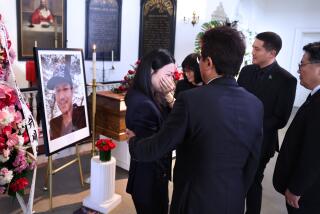Widow Campaigns to Get More Asians as Marrow Donors : Health: Yae Ran Hyun strives to fulfill dying wish of leukemia-stricken husband.
- Share via
IRVINE — The Korean American patient had suffered a relapse of leukemia, and his chances of finding a donor with matching bone marrow for a transplant were slim--as they are with other minorities.
But through the yearlong efforts of Irvine resident Yae Ran Hyun, the UC Berkeley graduate student found a newly registered bone-marrow donor in Orange County. His doctor called the find a miracle.
Such a success story keeps Hyun motivated to carry out the dying wish of her late husband, Young Hwi Hyun, who couldn’t find a bone marrow donor to help him overcome leukemia.
“He said, ‘I’ll die, but no more people like me should die,’ ” his widow said.
To carry out her late husband’s wish, the 41-year-old Hyun has spent the past 16 months trying to encourage more Korean Americans to register with the National Marrow Donor Program as possible bone marrow donors.
Through her organization, Give Him a Life, which was founded four months before her husband’s death last December, Hyun has increased the number of registered Korean donors in the United States from 1,800 to 7,500. She hopes to boost that number to 30,000 by next year.
“The organization is not just for me, but for all Korean people,” said Hyun, who moved to California from Korea a few months after her husband’s illness was diagnosed in July, 1992. “My only motivation in doing this is to try to help other people.”
About 1.5 million people are registered with the national donor program in Minneapolis. Of these potential donors, only about 66,000 are Asian; 95,000 are African American and 90,000 are Latino.
“Minority groups have the least chance of finding matching donors because they have fewer donors in the registry,” said Jennifer Caliandro, spokeswoman for the National Marrow Donor Program. “It’s not impossible for a match to cross racial barriers, but tissue types tend to be more similar among people of the same race.”
The American Red Cross in Orange County, in fact, is looking for Filipino and other Asian Pacific donors for Nancy Alegado, a 20-year-old Filipino American who is critically ill with leukemia. The organization said the chances of finding a compatible marrow donor are greater within a similar ethnic group.
For Koreans and other Asian Americans, however, cultural beliefs discourage them from donating blood or any part of their bodies.
“According to traditional Confucian beliefs, our body is a gift from our ancestors, so we shouldn’t alter it in any way,” Hyun said. “Koreans also are fearful because they don’t really know what bone marrow is. The Korean word for bone marrow is similar to the word for brain, so they are instantly turned off.”
To educate people about the bone marrow donation process, Hyun has made presentations to dozens of Korean church and community groups across the country. She also has established branch offices for Give Him a Life in Los Angeles, San Francisco, Dallas, San Francisco, Seattle and Washington, D.C.
So far, Hyun said, two Korean American leukemia patients have been matched with donors she recruited.
One of those patients was the UC Berkeley student, Young Ho Moon, who recently underwent a successful bone marrow transplant at the Fred Hutchinson Cancer Research Center in Seattle. His donor is a Korean American woman in Orange County, whose identity wasn’t disclosed.
“If (Hyun’s) program wasn’t there, the chance of me finding a donor would be almost none,” said Moon, 29.
“It was a long shot, but this just came out of the blue.”
Moon, who went into relapse a few months before his operation, said an initial search through the national registry found only one possibility, a donor who still would have had to undergo tests to see if the marrow types matched.
“The doctors told me that normally a Caucasian person would have 20 to 100 possible donors after a preliminary search,” said Moon, who hopes to return to school next fall. “Then there’s only a 20% chance that any of those potential donors would match. So I knew my chances were really slim.”
Then the Orange County donor was placed on the national registry.
She was a perfect match.
“It was a miracle that a newly recruited donor would be a perfect match,” said John Hansen, one of Moon’s doctors at the cancer institute.
“The whole donor program depends on this type of grass-roots community effort to increase the number of donors. Lives are being saved because of these efforts.”
Hyun’s efforts go beyond merely registering donors.
When she hears of a Korean American with leukemia or blood disease, she visits them at her own expense and offers them advice based on her own experiences. So far, she has made about 16 trips to various cities across the country.
“Whenever I see a patient, I think of my husband and that makes me want to help them,” said Hyun, who has two teen-aged children. “I’m a strong believer that people have to spend their lives trying to help other people.”
To become registered, donors must be between 18 and 55 and in good health. A small sample of their blood is tested to determine its marrow type, and their names are placed in the national registry. The usual fee is waived for minority donors.
If a match is made, a small amount of marrow is collected from the donor’s pelvic bone. Although the donor may experience some pain, bone marrow naturally replenishes itself within a few weeks.
More to Read
Sign up for Essential California
The most important California stories and recommendations in your inbox every morning.
You may occasionally receive promotional content from the Los Angeles Times.










